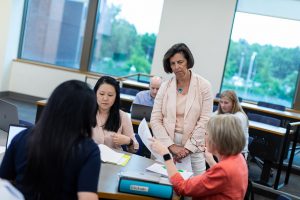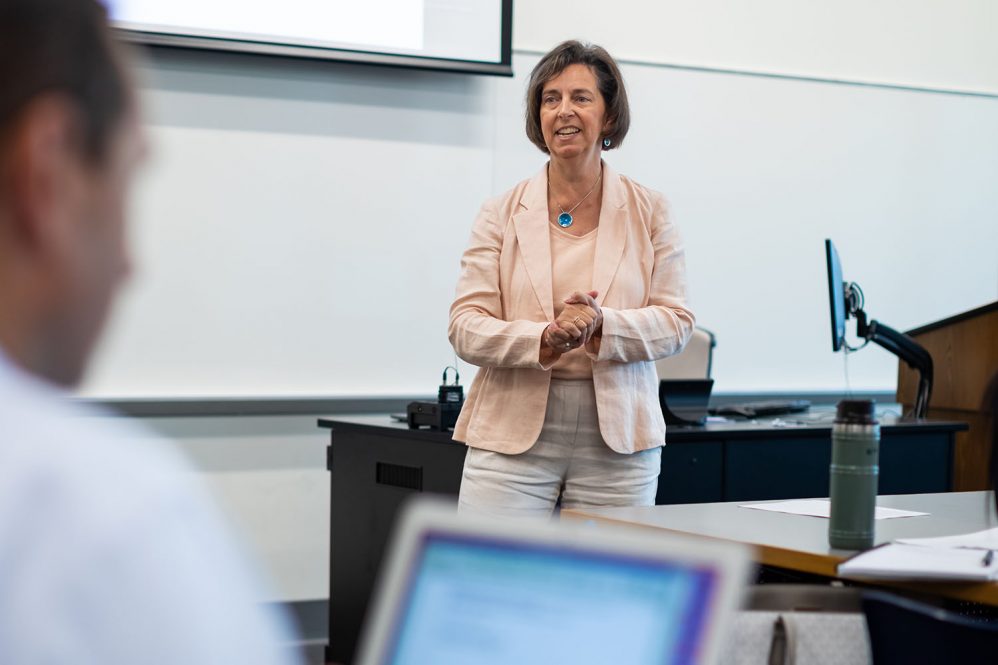Kelly Lyman, coordinator of the Neag School of Education’s Executive Leadership Program, has more than 30 years of educational leadership experience, including serving as superintendent in Mansfield, Connecticut. In a recent interview, Lyman emphasized five essential qualities for superintendents: communication, team building, operational flexibility, instructional knowledge, and problem-solving.
Lyman underscores leadership as paramount, requiring a comprehensive understanding of instructional and operational aspects.
“Collaborative team building is crucial to realizing a unified vision,” she says. “Problem-solving skills prevent entanglement in operational details, keeping focus on broader goals. Clear communication with stakeholders fosters shared understanding.”
Lyman emphasizes the research-backed significance of communication, shared vision, and team building. Simultaneously, she highlights the value of instructional knowledge and operational flexibility derived from hands-on experience in curriculum and instructional practices. These qualities collectively contribute to a successful superintendency, balancing theoretical insights with practical wisdom gained from years in educational administration.
Communication
According to Lyman, effective communication is paramount for a superintendent, especially in crisis management, policy explanation, and response to criticism: “Swift and clear messaging is crucial to prevent others from shaping the narrative.”
Lyman stresses the role of communication in fostering a shared vision: “While research emphasizes a well-defined vision, authentic leadership involves collaborative vision development. This requires two-way communication from the executive team to teachers, students, and parents.”
While research emphasizes a well-defined vision, authentic leadership involves collaborative vision development. This requires two-way communication from the executive team to teachers, students, and parents. — Kelly Lyman
Ensuring stakeholder involvement in decision-making is integral to communication, she suggests. It goes beyond seeking input to actively engaging stakeholders in shaping initiatives, particularly for critical matters. Lyman cites her experience in Mansfield, where inclusive communication resolved community division over aging elementary schools. The school board incorporated community feedback through input sessions and discussions, emphasizing the importance of inclusive communication in addressing complex issues.
“The approach, contrasting traditional surveys, showcased the significance of actively involving the community in decision-making,” she says. “Effective communication for a superintendent involves clear messaging, collaborative vision creation, and stakeholder involvement in critical decision-making.”

Team Building
Lyman says superintendents play a vital role in cultivating a shared vision within their educational community by building strong relationships and teamwork among their executive team, administrative staff, and the board of education.
“In thriving districts, the board actively shapes the shared vision, enabling effective advocacy for school goals,” she says.
Lyman emphasizes effective leadership in ensuring organizational coherence and utilizing the team’s capabilities.
“Developing a strategic plan involves engaging the community to establish widely agreed-upon core beliefs, from which strategies and actions derive,” she says. “Maintaining coherence requires aligning all school activities operationally with the shared vision and core beliefs.”
Developing a strategic plan involves engaging the community to establish widely agreed-upon core beliefs, from which strategies and actions derive. — Kelly Lyman
Reflecting on her experience in Mansfield, Lyman highlights the rapid creation of a strategic plan within her first 90 days. The plan originated from a one-page summary of community insights, shaping core beliefs validated through community input. Specific goals aligned with these beliefs were incorporated into the plan, emphasizing the importance of living these principles.
“Annual action plans, prioritizing clarity and community involvement, resulted in a well-defined, community-informed strategic plan that fostered coherence and transparency,” she says.
Operational Flexibility
According to Lyman, superintendents must have a functional understanding of various operational systems in education. While not requiring expertise, they should grasp such functions as the mechanics of transportation, food services, HR, and special education to ensure alignment with core beliefs and goals.
“This knowledge facilitates prompt operational changes, whether in budget allocation or program design, when necessary,” she says.
Superintendents must have a functional understanding of various operational systems in education. — Kelly Lyman
Understanding system intricacies supports effective problem-solving, allowing superintendents to be more hands-on in addressing issues. Regular communication with system personnel is crucial, involving ongoing engagement through reports and discussions to stay informed. This approach enhances the superintendent’s ability to navigate operational challenges while aligning with educational goals.
Upon entering a new position, Lyman recommends superintendents personally tour district buildings, gaining insights by walking through with the facilities head.
“This hands-on approach addresses maintenance issues and allows identification of concerns such as asbestos presence,” she says.
Lyman emphasizes learning from system leaders in the district through regular communication, suggesting quarterly meetings with the food service director, for example, to stay informed about staffing, finances, and compliance with laws and regulations.
Instructional Knowledge
Instructional knowledge is a cornerstone for superintendents, Lyman says, as it forms the foundation of their role.
“A deep understanding of the curriculum is crucial for engaging in meaningful conversations with parents and the public, addressing concerns about specific classes,” she says. “Instructional knowledge is pivotal for evaluating and enhancing educational programs within a district.”
“Superintendents need to be well-versed in best practices, educational research, and the intersection of curriculum and instruction to effectively lead their teams and guide staff in improving teaching and learning,” she says. “They also need a commitment to continuous learning, delving into one educational area each year to accumulate expertise over time.”
Instructional knowledge is pivotal for evaluating and enhancing educational programs within a district. — Kelly Lyman
Furthermore, Lyman recommends cultivating instructional knowledge within the leadership team and teachers. “Fostering ongoing dialogue about instruction and curriculum during administrative meetings nurtures a culture of professional growth, enhancing educational outcomes.”
In Mansfield, Lyman promoted teacher leadership through curriculum teams led by school administrators and teacher leaders.
“This collaborative approach, as opposed to relying solely on a curriculum assistant superintendent, created a culture of shared responsibility,” she says. “Quarterly administrative meetings with instructional round tables allowed principals to share curriculum teamwork, fostering awareness and coherence.”
Lyman notes the importance of practices trickling down to classrooms by involving teachers. In addition, instructional rounds, focusing on understanding best practices rather than evaluation, facilitated administrators spending time in each other’s schools.
“This approach enhanced the understanding of instruction and equipped the leadership team with new knowledge about effective educational practices,” she says.
Problem-Solving
Wrapping up the last essential skill for superintendents, Lyman notes that “problem-solving is a crucial leadership quality that propels organizational progress and inspires confidence in leaders.”
“In education, leaders face diverse challenges, from improving academic performance to addressing everyday issues like late pickups and responding to crises,” she advises. “Effective problem solving requires composure, clear communication, and adaptability, often overlapping with crisis management.”
Exceptional problem-solving abilities contribute to organizational resilience, ensuring continuous advancement. Lyman highlights the importance of intangible qualities such as maintaining a level head and rational decision-making.
“Leaders with strong problem-solving skills navigate challenges confidently, reinforcing trust among team members,” she says.
Problem-solving is a crucial leadership quality that propels organizational progress and inspires confidence in leaders. — Kelly Lyman
Lyman recounts a significant problem-solving situation in Mansfield related to transportation issues: “We were facing driver shortages and long bus routes. I implemented group bus stops for middle and high school students, which triggered safety concerns.”
To address this, she conducted extensive analyses, engaged with parents, and held the bus company accountable through meetings and ongoing updates with the board. Despite challenges, her comprehensive approach, including pursuing new contracts and collaborating with the chosen provider, significantly improved transportation services.
“The problem-solving process involved understanding the system, building knowledge, constant communication with stakeholders, and collaborative engagement with service providers,” she says.
Despite initial hiccups with a new provider, the situation stabilized over time, resulting in lasting success. Lyman’s experience exemplifies the effectiveness of a thorough and collaborative problem-solving approach in overcoming significant challenges within a school district.
Learn more about the Neag School’s Executive Leadership Program at executive.education.uconn.edu.



